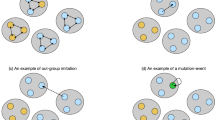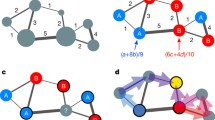Abstract.
The paper provides an explanation for altruistic behavior based on the matching and learning technology in the population. In a infinite structured population, in which individuals meet and interact with their neighbors, individuals learn by imitating their more successful neighbors. We ask which strategies are robust against invasion of mutants: A strategy is unbeatable if when all play it and a finite group of identical mutants enters then the learning process eliminates the mutants with probability 1. We find that such an unbeatable strategy is necessarily one in which each individual behaves as if he is related to his neighbors and takes into account their welfare as well as his. The degree to which he cares depends on the radii of his neighborhoods.
Similar content being viewed by others
Author information
Authors and Affiliations
Additional information
Received June 1996/Revised version October 1998
Rights and permissions
About this article
Cite this article
Eshel, I., Sansone, E. & Shaked, A. The emergence of kinship behavior in structured populations of unrelated individuals. Game Theory 28, 447–463 (1999). https://doi.org/10.1007/s001820050119
Issue Date:
DOI: https://doi.org/10.1007/s001820050119




